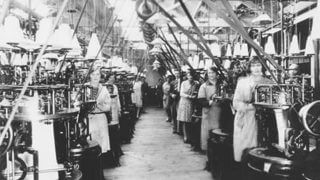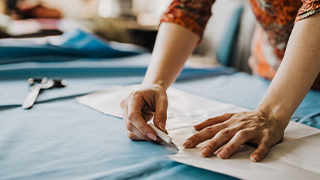Sock Components
Sock Components Overview
Whether socks are designed for function or fashion, most socks share the same basic components: the top or welt, leg, heel, foot, and toe. Each component can be altered or enhanced to meet end-use specifications.
Welt Formation
The welt is very important because it is the starting point of the sock and provides an edge that will not ravel. It is important to fit, and it may be seen, depending on the sock design. If the welt is a single jersey base, a dial is mounted concentrically with the cylinder and rotates with it. The dial contains transfer points or jacks that engage the beginning courses of the sock and hold them until sufficient fabric for the welt has been knitted, whereupon the transfer points return the fabric to the needles.
Heel Pocket Formation
A key aspect of a well-fitting sock is the formed heel. Sock machines are designed to allow for the knitting of extra fabric in the shape of a heel. This type of heel is referred to as a “heel pocket.”
Toe Pocket Formation
As with the formed heel, the best-fitting socks have a toe pocket. Yarn selection and reciprocation of the cylinder are important for toe-pocket formation. Also, having more courses in the bottom of the toe than in the top of the sock will result in the toe seam being on top of the toes, which provides better comfort than having the seam at the end of the toe or under the toes.
Cushioning
A common component of socks is a cushioned sole. Terry loops can be added throughout the sole to provide cushioning for the foot. An added benefit of terry is improved wicking of moisture from the skin.
Reinforcement
A reinforcing or splicing yarn is frequently used to form a heavier fabric in the parts of hosiery that are subjected to the greatest wear. These areas are the portion of the ankle above the heel, commonly called the “high heel” or “spliced heel,” and the sole, referred to as a “double sole.”
Patterning
Patterning, or the design of socks, is based on costs, end use, and fashion. Commodity socks tend to use single patterning of the knitted stitch and are primarily single jersey throughout the sock, with a stretch yarn in the leg portion. The benefits of including stretch yarns in the leg portion are to help hold the sock up and to attain knitted rib appearances without having to knit on a cylinder-and-dial machine. Cylinder-and-dial machines or double-cylinder machines offer more pattern capabilities.
Texture Effects
Texture effects can be achieved in various ways, affecting the sock’s appearance, performance, and cost. Various types of textured yarns are available. Synthetic yarns may have high bulk and stretch properties, and spun yarns may be made with varying yarn diameters. Single-spun, plied, or wrapped yarns may be used alone or in addition to textured yarns. The use of tuck and float stitches can further accentuate the texture. Finally, the manipulation of the needles by omission or needle transfer, as in the links-links stitch, can achieve diverse desired effects.
Yarn for Socks
Many types of yarn, of either natural or synthetic fibers, can be used for sock manufacturing. Either stretch or non-stretch (“hard”) yarns can be used. In most socks, stretch yarns are used for better fit and performance. The yarns also be dyed or undyed.


